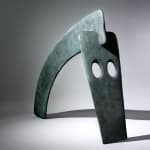William Turnbull 1922-2012
181.5 x 73.6 x 205.1 cm
‘Turnbull built plaster on top of a metal armature to make Horse, 1946. This piece forms a horse's head from a series of interlocking planes, both three-dimensional, flattened and frontal, exploring Cubist ideas of simplifying subjects to elemental shapes in a sculptural form.’ 1 At the time, Turnbull was a regular visitor to the British Museum, which was only a few streets away from the art school. The horse's strong profile and arched neck is typical of classical Greek sculptures in the museum’s collection, such as The Horse of Selene, c.438-432 B.C., a fragment from the Parthenon.
Turnbull produced three works on this subject in the early 1950s: Horse, 1950 (coll. Tate Gallery), made in Paris, which presents an entire horse, albeit with details radically reduced, its thin, splayed legs reminiscent of a child’s toy; Pegasus, 1954, an abstracted, winged horse, recalling the sculpture on the Opéra National de Paris; and finally, Horse, 1954 (coll. Tate Gallery), which focuses on the horse's head and neck, reviving elements of the first ‘Cubist’ work. This fourth incarnation has a primitive approach to form inspired by early African wood carvings and ancient Greek masks. Turnbull felt it unnecessary to depict the complete figure of the horse, noting how in African sculpture ‘the part can represent the whole…you can feel the whole animal is in that one component’. 2
After a 33-year gap, Turnbull returned to this subject in 1987 and of the 12 works he created thereafter, all in some way refer back to Horse, 1954. In 1988-9 and 1990, Turnbull produced two very large bronzes, both around 3 metres high and later, this present, large-scale horse in 1999, essentially reprising his 1988-9 bronze at a slightly reduced, more human scale. Davidson notes the explicit reference to an adze (Stone Age axe) in these later works, suggesting the horse’s role as the tool/servant of man. The physical power of this animal and its myriad associations with war, history and mythology, offered an ideal subject for a sculptor whose work was both timeless and at the same time astonishingly modern. The large horses have been exhibited outdoors in London and Paris, and, to spectacular effect, in rural locations including the Yorkshire Sculpture Park and Chatsworth House, Derbyshire (pictured).
1. Amanda A. Davidson, The Sculpture of William Turnbull, The Henry Moore Foundation in association with Lund Humphries, London, 2005, p12
2. Ibid p29
Provenance
Estate of the Artist
Exhibitions
London, Waddington Galleries, William Turnbull, Horses: Development of a Theme, Other Sculptures and Paintings, 22 June - 20 July 2001, cat no.8, illus colour p19 (3/6 exhibited)
London, Waddington Galleries, William Turnbull, Beyond Time, 9 June - 3 July 2010, cat no.25, illus colour p73
Bakewell, Chatsworth House, William Turnbull at Chatsworth, 10 March - 30 June 2013, cat no.48, illus colour p84
Literature
Amanda A. Davidson, The Sculpture of William Turnbull, Henry Moore Foundation / Lund Humphries, Aldershot, 2005, cat no.301, illus b/w p190



